Some Unusual Aspects of Train Operation
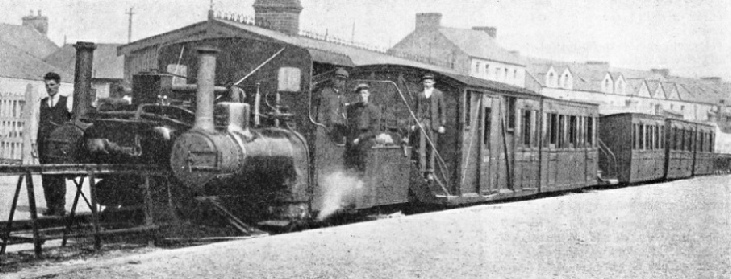
A LARTIGUE MONORAIL TRAIN on the former monorail line which was laid between Ballybunion and Listowel, in County Kerry, Ireland. The 10-miles stretch of track consisted of a single rail carried along the top of a low A-shaped trestle, on which the vehicles ran astride. Twin locomotives, with separate boilers, fireboxes, and smoke-boxes, had each three coupled wheels of 2 ft diameter running along the single rail. There were also four guide wheels, bearing against the guiding rails. The maximum speed was restricted to 18 miles an hour.
THE unconventional, whether in human beings or in inanimate objects, generally attracts attention. If the underlying idea is merely odd or freakish, public attention will not be sustained. If on the other hand a sound idea underlies the presentation, there is a reasonable probability - but no certainty - that the idea will be developed.
This chapter will deal mainly with ideas and inventions that have had varying fortunes. Some have thriven for a time, but are now in a state of suspended animation; others have expired after an uneasy adolescence; others again have never yet seen the light of day.
Everything is strange when it is first introduced, and more or less in the experimental stage. The first electric tube railway - the City and South London - was in this category until the Central London and the Waterloo and City came to keep it company. So we will rule out successful experiments of this order. At the same time reference may be made to the first tube railway in the world, which was not the City and South London. It was in use before the opening of the Tower Bridge, and ran under the Thames from Tower Hill to Southwark. The tube was very small, and transit was provided by a diminutive cable tram-car. Kiosk structures with stairways provided access at either end. This Tower Hill Subway was not an unqualified success, though it was a praiseworthy, if inconspicuous, experiment. The car frequently ran off the rails and got stuck. So the rails were taken up, the tram was removed, and the tunnel converted into an ordinary foot subway. As such it was a peculiarly gloomy place, rather suggestive of a large drain. With the coming of Tower Bridge, this first London tube became redundant, and now it serves to carry electricity mains under the river; forgotten, but still useful.
Another forgotten experiment of this kind was the Pneumatic Conveyance Company, which many years ago was tried for the underground transport of mail-bags, as explained in the chapter “The Post Office Railway”.
This forerunner of the present wonderful Post Office Tube had a very small bore, and cylindrical four-wheeled cars were shot through it by compressed air. A daring actress achieved unusual notoriety by allowing herself to be shot through the tube in one of these cars; a plucky if foolhardy thing to do; for, to avoid injury, she had to crouch down in the manner of a rabbit in a burrow.
Whether we shall yet see trains running on one rail is still a matter for speculation. Several decades ago, in his novel, “The War in the Air”, Mr. H. G. Wells forecast them as an immediate probability; but for once, that remarkable prophet was wrong. A younger novelist, Aldous Huxley, has described them in one of his books as being in use six hundred years hence, which is a safe enough distance away.
A long time ago, the French engineer Lartigue invented a monorail system in which the single rail was mounted on a tri-angular trestle, with guiding rails on each side. The vehicles had twin bodies, hanging over on both sides of the running rail, and balancing one another. Several Lartigue lines, operated by horses or mules, were laid down in North Africa and elsewhere; then on March 1, 1888, a steam-driven Lartigue railway was opened between Listowel and Ballybunion, in south-western Ireland. The rail of the Ballybunion Railway was raised three feet above the sleepers, with the guiding rails eighteen inches below it. The locomotives, built at Leeds by the Hunslet Engine Company, had each two boilers, two bunkers and two water-tanks, balanced on either side of the rail, with the cylinders, motion, and driving wheels between them. Passenger coaches, cattle trucks, and wagons were of similar twin construction, the passengers sitting with their backs to the rail. As the carriages had to be entered from either side, and as there was naturally no transverse passage through them, steps were provided between them whereby passengers could easily climb over the rail. It was an odd arrangement, though such a railway was very cheap to construct. Level crossings, of course, were impossible, because of the elevated rail, and roads were carried across the line by a clumsy form of drawbridge, worked by winches and carrying automatic signals. The Listowel and Ballybunion Railway remained the only Lartigue monorail line in the British Isles, but it continued to work for many years until, in 1924, its traffic was killed by the ubiquitous lorry and motor bus, and it closed down. A short reference to this line is made in the chapter “Elevated and Mono-Railways”.
In the early years of the present century a great deal of attention was attracted to the invention, by Mr. Behr, of a high-speed electric monorail line. Surveys were made, and a Behr monorail was proposed between Liverpool and Manchester. The Behr system resembled that of Lartigue in that the rail was to be mounted on a trestle of triangular section, but the line was to be of much heavier construction, with a view of obtaining normal running speeds in excess of a hundred miles an hour. The “train” would have consisted of a single very large electric motor coach. Two rows of passengers would sit with their backs to the rail, in deep armchair seats, while two other rows of similar seats were to face them along the outer sides of the car. It is believed that Mr. H. G. Wells had the Behr railway in mind when he described futuristic trains in “A Modern Utopia” and “In the Days of the Comet” but those in “The War in the Air”, which we have already mentioned, appeared to be of the gyroscopic type, running on one simple rail with no balancing rails at all. The Liverpool-Manchester monorail was never built.
Gyroscope Control
The gyroscopic monorail next calls tor attention. The invention of this type which attracted most attention in the past was that of Louis Brennan. A gyroscope may be likened to an enormous spinning top, and in a gyro-car it conveys its own powers of balancing to the vehicle on which it is mounted. Brennan mounted gyroscopes on his car, and these were caused to revolve at 2,000 to 3,000 revolutions per minute by electric motors. The car itself was propelled by a petrol engine. At the Japan-British Exhibition of 1910, a full-size monorail was constructed to the designs of Mr. Brennan, and on it there ran a double-bogie car which carried people who were bold enough to try the experiment. A single flat-bottomed rail was used, laid on ordinary timber sleepers. A smaller car designed by Brennan succeeded in carrying its inventor across a tightly stretched wire rope, and a model of this may be seen at the Science Museum, South Kensington.
The weak point of Brennan’s system, as of any gyroscopic monorail, was that, while the locomotive or motor coach could balance itself, it could not balance any trailer cars as well, and that if these were to have their own balancing mechanism, the train would have been a heavy, complicated, and expensive piece of work with only limited passenger or goods accommodation. The system invented some time back by the Russian, M. Shilovski, was an attempt to overcome this problem. It also involved the use of the gyroscope; but what was known as Shilovski’s Gyroscopic Stabilizer was to be employed. Two or three of these devices were to be included in a train consisting of a locomotive and several vehicles. Models were built, including a steam tank locomotive with two driving wheels and a bogie at either end. Although the engine had but one set of wheels, its side elevation resembled that of an orthodox 4-4-4 tank engine. The Shilovski models were demonstrated with some success, but the practical application of the invention to full-size railways was, apparently, another matter.
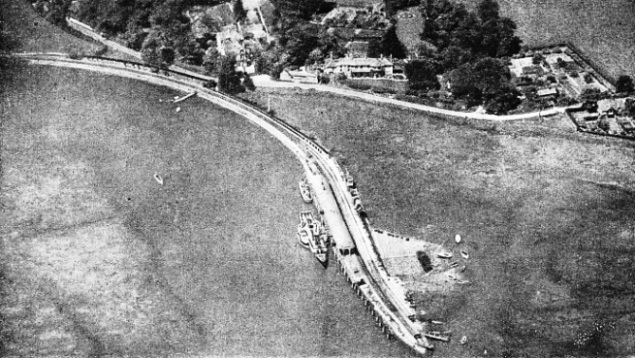
A STATION ON A PIER. Lymington Station, in Hampshire, belonging to the Southern Railway, is built on a pier, as it also forms the landing stage for the company’s boat service between the mainland and Yarmouth, in the Isle of Wight. The landing stage is half a mile from the mouth of the river, because it was necessary to construct a pier that could be used at low tide.
Kearney’s High-speed Railway was an invention involving the use of a running rail with an overhead balancing rail, small balancing bogies being mounted on the roofs of the cars. It was claimed that a Kearney car could surmount much steeper gradients than one of the ordinary type, thereby permitting the construction of deep level tubes with the stations quite near the surface, as are those of the Glasgow Subway. Proposals have been made at various times for the construction of an underground railway on the Kearney system, notably on the Tyneside, but though the invention shows, perhaps, much more promise as a practical proposition than the Brennan or Shilovski systems, such a railway has yet to be constructed.
It may be asked what was the point of these experiments in monorail design. The running of a train or rail-car on one rail instead of two would naturally decrease the amount of flange friction, thereby allowing for greatly increased speeds, and the surmounting of steeper gradients. But, so far, the disadvantages have outweighed the advantages. Nevertheless, with the present advance of rail-car design, involving the frequent running of single cars instead of longer trains at less frequent intervals, it would be rash to ridicule several half-forgotten experiments.
In the adjoining towns of Barmen and Elberfeld, in Germany, an electric “hanging” railway has been at work for many years. On this, the cars hang from a rail mounted on overhead girders. Speeds of over thirty miles an hour are attained, so the railway provides a rapid form of travel.
Interesting Experiments
In places the line is carried above the River Wupper, where it provides a striking, though hardly beautiful, addition to the landscape. The Germans call it a Schwebebahn, or “swinging railway”. The line is illustrated in the chapter “Elevated and Mono-Railways”. Slightly resembling the Barmen-Elberfeld line, at first sight, is the “Railplane” described in the chapter “A British Railplane”.
Two interesting experiments were put into practice at the British Empire Exhibition, Wembley, during 1924 and 1925. One of these was known as the “Neverstop Railway”, and ran the length of the Exhibition grounds. A similar, though smaller line, had previously been installed in an amusement park at Southend. The “Neverstop” cars ran on two rails in the ordinary way, but they were driven by a revolving continuous screw, laid in a pit between the rails. The thread of this screw varied in pitch at different places; at the stations, the pitch was so fine that the cars crawled past the platforms at a bare walking pace, and were easily boarded. Between the stations the screw pitch was increased, so that the cars ran at a considerable speed. The cars engaged with the thread of the screw by means of horizontally mounted rollers between and below the running wheels. Such a line would only be of use over short distances in towns. It is still possible to see at Wembley the concrete viaducts which carried this interesting line. The other line at Wembley appeared at first sight to be a simple narrow-gauge railway on which the trains were drawn by internal combustion tractors or “Sentinel” geared steam engines. The tractors, however, had their driving wheels outside the rails and fitted with rubber tyres, so that, though the carrying wheels and the cars behind ran easily on the smooth rails, the driving wheels bit into the ballast. This arrangement allowed the use of a comparatively heavy engine on lightly laid track.
We will now deal with some “might have-beens”. The Panama Canal is now so well established that the days of “rounding the Horn” are well-nigh forgotten, save by the old generation of seafaring men. But long before the Canal was built, an American engineer called Eads conceived a weird notion of ferrying ocean-going ships across the Isthmus of Panama by means of a giant railway. This “ship railway” was to have twelve rails, set in two tracks of six rails each. The rails would have run down a shelving causeway into the Pacific at one end, and into the Caribbean Sea at the other.
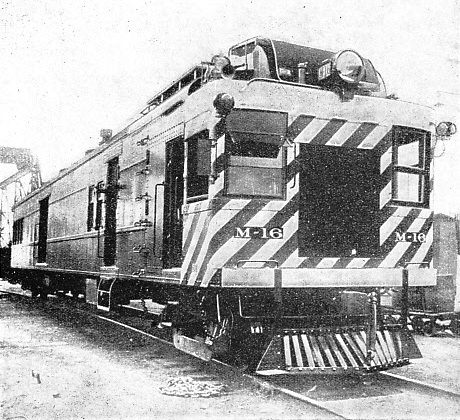
TO PREVENT ACCIDENTS at level crossings, the Alton Railroad, a subsidiary of the Baltimore and Ohio Railroad of America, has adopted striking designs for its rail-cars to draw the attention of drivers of road vehicles. Here is one of the rail-cars painted with broad black-and-white stripes to make it conspicuous.
The procedure adopted for ferrying the ship was to have been as follows. At low tide a gigantic wagon, resembling a slipway on wheels, would have been run down to the extreme limit of the line, in deep water. At high tide the ship to be ferried would manoeuvre over this vehicle. When the tide went out again, the ship would then settle down on to the wagon on an even keel, and it would be hauled ashore by two giant steam locomotives, each with six sets of wheels, the ship-carrier having twelve sets The ship was then to be trundled overland to the farther terminus, and there committed once more to its natural element. Mr. Eads’ scheme was fantastic but ingenious. Theoretically it was not unsound, though the extraordinary business of rolling the ships across the Isthmus in this cumbersome way would have proved far too costly in operation.
The capacity of the “ship railway”, too, as compared with a canal, would have been woefully small, for the transport of each ship would have taken at least a day to accomplish. So the Canal came instead, but it was long in coming, and was not opened till 1914. The notion of laying the rails at either end of the “ship railway” down into deep water was not quite so extraordinary as it sounds. The idea took concrete shape at Brighton, as explained in the chapter “Brighton’s Electric Railway”. A semi-sub-marine railway, generally similar to the old electric line from Brighton to Rottingdean, still crosses the harbour at St. Malo, in Brittany. When Eads’ Panama “Ship-railway” was proposed, ocean liners were, of course, much smaller than they are to-day.
It must be remembered, on the other hand, that the principle of the “Ship Railway” has been successfully applied on a small scale. In the chapter “America’s First Trains” appears an illustration of the Portage Railroad across the Allegheny Mountains, on which sectional canal boats were run up inclined planes by means of a stationary engine. Quite probably it was this which gave Eads his much more ambitious but less workable idea for crossing the Isthmus of Panama. A modern instance also occurs on the Overland Canal built by German engineers between Elburg and Prussian Eylau, where the small canal steamers are transferred from one level to another by means of cable-operated broad-gauge railway tracks. This is the nearest approach to Eads’ scheme ever constructed. Nobody has yet made a practical trial of locomotive traction on such work.
Now we have to consider two more “might-have-beens”, both in London, and both locomotives. When the first under-ground lines were being built in London there was a good deal of anxiety about the smoke and fumes in the tunnels, which alarmists declared would suffocate all the passengers and cause appalling disasters. The electric train was then but a dream of the future, and Sir John Fowler, the first engineer of the Metropolitan Railway, did his utmost to produce what would, in effect, be a smokeless locomotive. He made a remarkable attempt, but details of its construction were kept secret; the trial trips were carried out in the dead of night. For these reasons the first “smokeless locomotive” speedily became known as “Fowler’s Ghost”.
Smokeless Locomotives
The “Ghost” was built by Robert Stephenson and Company in 1861, two years before the Metropolitan was first opened, It was a broad gauge engine; otherwise very little was known about it at the time, though people whispered that it “went by hot bricks”. The engine was a 2-4-0; most of the length of the boiler barrel contained a long “combustion chamber”, in which bricks were kept incandescent by a small firebox behind the trailing axle. Outwardly the “Ghost” was quite ordinary in appearance, with the usual chimney, dome and safety-valves, together with a four-wheeled tender. It was tried on the Great Western main line, but its progress was disappointing, and it barely managed to get home under its own steam.
Before this, in 1860, tentative designs had been prepared for another “hot bricks” locomotive, which would have been a 4-2-2 tank engine with a boiler rather similar to that of the “Ghost”, and the addition of a huge cylindrical steam space above the boiler barrel proper. This design went no farther than paper, and was completely forgotten for more than half a century, until the researches of that great authority on early locomotives, the late Mr. Rosling Bennett, at last brought to light the true history of “Fowler’s Ghost”, together with that of this other “ghost” which never appeared at all.
Subsequently a trial was made with a wagon on which a crude form of electromagnetic motor was mounted. On its trials it crawled into the tunnel between King’s Cross and Gower Street and stuck there, after which it was hurried away into the limbo of forgotten inventions. Then, in 1888, a six-wheeled electric locomotive, deriving its current from batteries, was built under the sponsorship of the Electric Traction Company. This was an advance on the electro-magnetic goods wagon arrangement, but even so it could propel itself only at a crawl. One day, however, it ran, or rather crept, away, and went along the Inner Circle all the way from Gloucester Road to Baker Street, when it was intercepted and stopped. Not until the last years of the nineteenth century did the modern type of electric train come to provide the ideal “smokeless locomotive”.
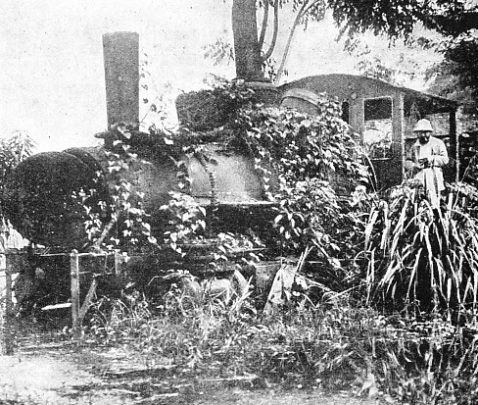
CHECKED BY NATURE. In Dutch Guiana, near the River Maroni, which is liable to floods, it has been impossible to operate a railway line. The locomotive shown above had to be abandoned to the swamp and the tropical vegetation.
This early Underground “Electromotive” does not seem to have been much of an advance on Robert Davidson’s electro-magnetic wagon on the Edinburgh and Glasgow Railway, to which a passing reference is made in the chapter “Some German Achievements”. Davidson’s invention has a vague enough history, but this much is known about it: it consisted of a four-wheeled wagon, carrying six storage batteries formed of zinc and iron plates immersed in dilute sulphuric acid. Two wooden cylinders on the axles had each three strips of soft iron mounted transversely on them. Both axles had two large electro-magnets mounted on either side, that is to say, there were eight magnets in all. The current was conducted from the batteries to these magnets, which thus “pulled the axles round”.
The vehicle weighed six tons and succeeded in propelling itself at four miles an hour, which was a remarkable performance for the first half of the nineteenth century. As it stood, of course, Davidson’s machine was anything but a commercial proposition, but he had got the idea of electric traction roughly half a century before the successful experiments of Siemens. The Edinburgh and Glasgow Railway were sufficiently impressed to buy the apparatus, but that was the end of it, and nothing more was done. When we reflect on the time and money which was spent in trying to perfect the Atmospheric System, it seems strange that nobody realized how very great were the elements of Davidson’s invention. Davidson really stands in relation to Werner Siemens as Murdoch does to George Stephenson.
Runaway Engines
The reference to runaways is a reminder that at one time and another, perfectly ordinary and respectable locomotives have “taken holidays” on their own account. Many years ago a London, Brighton and South Coast engine down in Sussex ran away because a cleaner had opened the regulator a little way without realizing what he had done. This man wanted to have the engine moved to get at a part of the motion. After his - as he thought - ineffectual attempt to move her, he went off in search of an engineman to do it for him. When they returned they were in time to see the engine running quietly off into the morning mists with nobody on the footplate. They gave chase, and one of them succeeded in laying his hand on one of the buffers, but he was too exhausted to swing himself on to the footplate. The engine vanished. Some time later, miles away, a railway man was walking along the track to his work at Horsham. He saw a light engine coming slowly along the line. On her buffers were sundry broken pieces of wood, which made him suspicious. As the engine passed him he saw that nobody was in charge; as she was going quite slowly he was able to catch her up and stop her. The wood he had seen on the buffers was the remains of a number of level crossing gates through which the wanderer had sailed during her unhindered progress. This was before the days of efficient telegraphic communication and block signalling, and as the event took place early in the morning nobody noticed what might have led to a major calamity, had the runaway met anything on the way.
The old South Devon engine “Brutus” once took a similar trip by herself. On that occasion the regulator was jerked open through the engine being accidentally bumped in the rear by another. “Brutus” finished up half way through a building behind the buffer-stops.
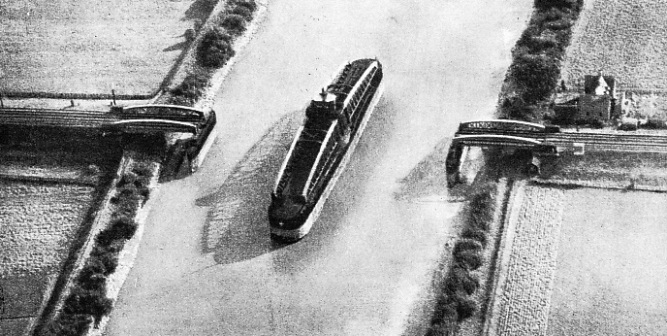
A SWING BRIDGE at Goole, Yorkshire, carries the LNER line from Doncaster to Hull over the river Ouse. The swing portion of the bridge rests on an artificial island in mid-stream to allow river traffic to proceed to and from Selby.
Runaway locomotives are rare nowadays, but less than fifteen years ago one of the late Mr. Dugald Drummond’s well-known 0-6-0 goods engines was “bumped” by some runaway goods wagons at Ascot, on the Reading line of the Southern Railway. She set off, driverless and alone, along the line towards London. The signalman at Sunningdale reported that the engine passed his cabin at about sixty miles an hour, and arrangements were made to throw her off the track before she could collide with something and do immeasurable damage at the junction at Virginia Water. Fortunately for the engine, however, both fire and water were very low, and with the melting of the firebox lead “safety” plug, she stopped before reaching the siding.
But probably the most extraordinary fate which ever overtook a locomotive was that which befell a commonplace little six-coupled goods engine of the old Furness Railway Company, which was eventually incorporated in the LMS Railway. It happened on September 22, 1892. The engine in question was employed near Lindal, where mine workings had caused several subsidences on the surface of the ground, though none of these had been alarming. The driver of the Furness goods engine one day suddenly had the peculiar sensation that his machine was lurching forward. Steam having been shut off, he and the fireman jumped from the footplate. A bad subsidence had occurred, and a deep fissure was forming immediately under the forward end of the engine. The earth sank under the rails in a deep, funnel-like depression; the rails broke asunder, and the locomotive “went down by the bows” in the manner of a sinking ship.
The tender was hauled back to safety, but by the time the breakdown crane had arrived the engine had sunk deep down into the fissure, only the cab and footplate being visible, where they protruded out of a chaos of slipping earth. The engine was beyond all hope of salvage; gradually she disappeared completely into what is probably the queerest “grave” the world has ever seen. The sides of the fissure gradually fell in over her, completing the weird business of locomotive-sepulture. It was estimated that the engine finally came to rest about two hundred feet below rail level. The initial “plunge” lasted no more than half a minute.
Perhaps, thousands of years hence, people of another civilization will come across her accidentally in the course of some as yet unvisualized excavations, and she will be solemnly installed in one of their museums as a “perfect and unspoilt example of Neo-British steam chariot”. But as far as we are concerned the engine has in all probability gone for ever. This is the sort of story that might be expected in a country suffering badly from earthquakes and volcanic phenomena. It is strange to think of such a thing happening at a point not so very far from the West Coast main line north of Carnforth, over which the “Princess Royals” and “Royal Scots” run daily. Yet, in her earthy retreat, the lost Furness goods engine may possibly survive them all.
Obstructive Tactics
When, in the present chapter, we refer to “warlike railways”, we do not mean strategic or military railways. Strange as it may sound, in these decorous days, certain railways in Great Britain were once warlike in the literal sense, that is to say, they were extremely quarrelsome among themselves. Nowadays, with only four great railways and three joint railways, cut-throat competition between rival companies is no longer rife. But in days gone by, when railway companies were many and various, all manner of peculiar things used to happen.
In the Far North of the British Isles, the Great North of Scotland was a somewhat quarrelsome line. It had a deadly feud with the Highland Railway, which held the key to Inverness, and another with the Scottish North Eastern, which carried on the traffic to the South.
At Keith, where the Great North and the Highland were connected, the Great North would schedule their trains to leave just before “connecting” Highland trains arrived. This they did because they grudged the Highland its half of the Inverness-Aberdeen line. It is fairly certain that this performance was mainly responsible for the early construction of the Highland main line to the South via Perth, which took the through traffic away from Aberdeen. At Aberdeen, too, the stations were then about a mile apart. The Great North officials used to wait until they saw the through passengers from the other station hurrying towards their own, when they would slam the gates and start their train.
But these were merely obstructive tactics. In England, in at least two instances, the mutual dislike of rival railway companies may be said to have come to open warfare. Perhaps the most notable instance was the celebrated quarrel between the old London Brighton and South Coast line and the London and South Western Railway, which flared up in 1858. The bone of contention was Portsmouth, to which the Brighton line had access via Havant. On the completion of the newer line-from Godalming to Havant, it was leased to the London and South Western Railway, a company which the Brighton line disliked intensely, as it was a powerful next-door neighbour. Running powers had been legally obtained over the Brighton line from Havant, so the latter company had not a leg to stand on. Nevertheless, when the coming of through South Western trains to Portsmouth was announced, the Brighton people at Havant cleared for action. The first South Western train arrived at Havant at seven o’clock one morning, three hours before its schedule, for the South Western had been expecting trouble, and hoped to take the Brighton unawares. But the Brighton men had taken no chances. The South Western people found their way blocked by a Brighton engine, padlocked to the crossing, while several lengths of rail had also been taken up. The situation rapidly became ugly; there was a free fight between the railway men of the rival companies, after which the South Western train returned to Godalming without having entered Portsmouth at all. The London Brighton and South Coast had, of course, no right to do this sort of thing, but there was some angry wrangling before, towards the end of the same month, the South Western reached Portsmouth.

AN INGENIOUS INVENTION designed to enable non-stop trains to pick up and set down passengers. The principle involves the use of a detachable carriage resembling a slip-coach at the rear of the train. This carriage is mounted on a chassis equipped with another set of wheels of a gauge wider than that of the track. At the station these outside wheels engage with another track and the wagon—released from the train by a wire cable - mounts an overhead ramp. On the ramp the carriage that has passengers wishing to alight is brought to a standstill; the cable is automatically transferred to another coach that has passengers wishing to join the train. The second coach is drawn off the ramp by the moving train, to which it is re-attached by the cable as shown in the above picture of a demonstration model.
Six years before, at Nottingham, there had been a somewhat similar dispute between the Great Northern and the Midland Railway. On August 1, 1852, the Great Northern ran its first train into Nottingham, to the disgust of the Midland, which looked upon that city as its own property. The Midland men captured the Great Northern engine, and with the aid of several of their own, hustled it into a shed. The rails in front of the shed were then torn up, and the Great Northern engine held a close prisoner. Thus it remained for several months, while the rival companies went to law over the matter. The Great Northern won the action in the end, and ran to Nottingham until the present LNER succeeded it in 1923.
The old London and North Western was a rather lordly line in some ways, and once or twice conducted affairs in a high-handed manner. Thus, the company once arrested the passengers of a rival company’s train which had entered London Road Station, Manchester. But it caught a Tartar in the person of a lawyer, who promptly conducted an angry and completely successful suit against them.
Mixed Goods Traffic
Railways are called upon to carry some peculiar things at times. A few years ago, one of the items included in a sale of railway lost property was a stuffed alligator. Such luggage as this is comparatively rare, and it is strange, indeed, to find such a thing among the unclaimed parcels and umbrellas. But a far worse thing than the loss of a stuffed alligator once took place at a London goods depot. A large packing case, containing “not classified” goods, arrived without its label. There was nothing for it but to examine the contents with a view to determining its ownership. There was a surprise when it was found to contain ancient but obvious human remains, which were handed over to the police. An inquest was held, at the end of which the “remains” were very much the worse for wear. They were found to be those of a young woman or girl; there was “nothing to show how death had been caused, or whether it were the result of crime”. Life had been extinct for an indefinable period. Then the lost invoice suddenly turned up, and brought with it trouble for a number of people. The “young woman or girl” was a Peruvian mummy, and should have been sent to a museum in Belgium. She had been dead for thousands of years. She was packed up and sent off to Belgium, but the owners refused to accept their gruesome “goods” after all the damage which had been done by the unfortunate railway company, and the people at the mortuary. In the end the railway company had to pay heavy damages for the unlucky mistake.
The smallest railways may sometimes appear unusual, but they serve their purpose well and in a normal way. There is, however, a strange train which runs on a practically unknown railway in Dorset, and it is worth a passing notice. The railway is a little narrow-gauge industrial line which runs, in the interests of the china-clay traffic, between the Southern Railway near Corfe Castle and Goathorn Pier on Poole Harbour.
There are two tiny tank engines, one of them built locally as far back as 1868, a fleet of small unsprung wagons, and no train service in the time-table sense of the words. Goathorn village, however, is not on a main road; it stands isolated in the midst of heathery moors, and it has no school. The children of the village cannot be expected to walk twelve miles a day to Corfe Castle and back, so the clay-mining company which owns the railway runs a special train for their benefit. No tickets are issued, for the children belong to the firm’s own workers. The train consists of one of the ordinary clay trucks, roofed in and provided with rough wooden walls, and hauled by one of the little four-wheeled engines.
Unofficial carriage of non-fare paying passengers on industrial railways is not so rare, but the old Liskeard and Looe Railway, in Cornwall, was in another category. It was not passed for passenger traffic by the Board of Trade, so it “got round” things by ingenuity. Passengers were carried free, at their own risk, and their fares were collected by the simple expedient of charging for their hats and umbrellas as “goods”.
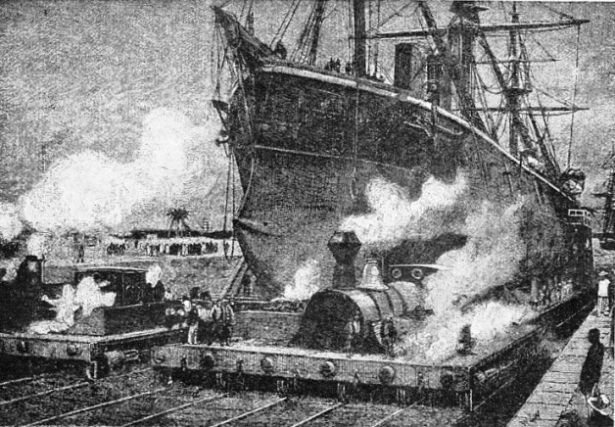 THE “SHIP RAILWAY” proposed by an American inventor for transportation across the Isthmus of Panama, before the building of the canal. This “ ship railway ” was to have had twelve rails, on which it was proposed to run a gigantic moving slip-way carrying the ship. The vessels were to have been manoeuvred on the slip-way at high tide.
THE “SHIP RAILWAY” proposed by an American inventor for transportation across the Isthmus of Panama, before the building of the canal. This “ ship railway ” was to have had twelve rails, on which it was proposed to run a gigantic moving slip-way carrying the ship. The vessels were to have been manoeuvred on the slip-way at high tide.
You can read more on “A British Railplane”, “The Atmospheric Railway”, “Brighton’s Electric Railway” and “Experimental Locomotives” on this website.









 THE “SHIP RAILWAY” proposed by an American inventor for transportation across the Isthmus of Panama, before the building of the canal. This “ ship railway ” was to have had twelve rails, on which it was proposed to run a gigantic moving slip-
THE “SHIP RAILWAY” proposed by an American inventor for transportation across the Isthmus of Panama, before the building of the canal. This “ ship railway ” was to have had twelve rails, on which it was proposed to run a gigantic moving slip-